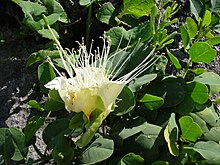Capparis
- "Capparis" is also a family name, see e.g. Melpomene Capparis.
| Capparis | |
|---|---|

| |
| Maiapilo (Capparis sandwichiana) | |
| Scientific classification | |
| Kingdom: | |
| (unranked): | |
| (unranked): | |
| (unranked): | |
| Order: | |
| Family: | |
| Genus: | Capparis |
| Species | |
|
Many, see text | |
| Synonyms | |
|
Atamisquea Miers ex Hook. & Arn. | |
Capparis is a flowering plant genus in the family Capparaceae which is included in the Brassicaceae in the unrevised APG II system. These plants are shrubs or lianas and are collectively known as caper shrubs or caperbushes. Capparis species occur over a wide range of habitat in the subtropical and tropical zones.
Uses and ecology

Caperbushes are mainly used by humans for their fruit, which are rich in micronutrients. C. spinosa, simply known as caper, yields fruit and more importantly flower buds, which are widely used pickled as a vegetable condiment. The fruit of other species, such as karir (C. decidua), are also used for cooking; C. mitchellii and the Wild passionfruit (the local subspecies of C. spinosa) are well-known bush tucker in Australia. Mabinlang seeds (C. masaikai) are eaten as sweets.
Mabinlang is also used in Traditional Chinese Medicine. Aspalathos, the root of a shrub contained for example in the sacred Ancient Egyptian incense kp.t (kyphi), is sometimes considered to be C. spinosa. Other species have also recorded uses in herbalism and folk medicine; dedicated research is largely lacking however. Mabinlins are sweet-tasting proteins found in Mabinlang seed (and possibly in other Capparis species); at least one of them is highly resistant to heat. The market for mabinlins is not large, but this is mainly due to insufficient supply rather than to lack of demand.
Caperbushes from arid regions - chiefly C. decidua - are highly useful in landscape gardening, afforestation and reforestation. They can stop soil erosion and preserve agricultural land. Any large-flowered species can be used to attract butterflies. The Crimson Rose (Atrophaneura hector), a spectacular swallowtail butterfly of South Asia, likes to visit flowers of C. spinosa in the winter months for example.

The fruit and seeds of caperbushes are relished by many birds and other animals such as spiny-tailed lizards. Capparis plants are highly important as food for certain Lepidoptera caterpillars, many of them Colotini or Pierini:
- Appias lyncida (Chocolate Albatross) - recorded on C. heyneana and C. roxburghii
- Astraptes fulgerator (Two-barred Flasher) - recorded on C. frondosa[2]
- Belenois aurota (Caper White or Pioneer) - recorded on C. zeylanica
- Cepora nerissa (Common Gull) - mainly on C. zeylanica
- Hebomoia glaucippe (Great Orangetip) - recorded on C. monii, C. roxburghii and C. "sepiaria"
- Ixias marianne (White Orangetip) - recorded on C. grandis[verification needed]
- Leptosia nina (Psyche) - recorded on C. zeylanica and others
- Pareronia ceylonica (Dark Wanderer) - recorded on C. heyneana[verification needed]
- Pareronia valeria (Common Wanderer) - recorded on C. zeylanica[verification needed]
The plant pathogenic ascomycete fungus Mycosphaerella capparis was described from a caperbush. Some species of Capparis are becoming rare, mainly due to habitat destruction, and a few are seriously threatened with extinction.
Selected species
- Capparis acutifolia Sweet
- Capparis arborea (F.Muell.) Maiden – Brush Caper
- Capparis baducca L.
- Capparis canescens
- Capparis crotonantha Standl.
- Capparis cynophallophora L. – Jamaican Caper
- Capparis decidua (Forssk.) Edgew. (= C. aphylla) – karir (kirir, k(h)air, karril, etc.)

- Capparis discolor J.D.Smith
- Capparis elegans Mart.
- Capparis fascicularis DC.
- Capparis fascicularis var. fascicularis
- Capparis frondosa Jacq.
- Capparis grandis
- Capparis heyneana
- Capparis humistrata (F.Muell.) F.Muell.
- Capparis indica (L.) Druce
- Capparis incana Kunth – Hoary Caper
- Capparis lasiantha R.Br. ex DC.
- Capparis loranthifolia narrow-leaf bumble-tree
- Capparis lucida (DC.) R.Br. ex Benth.
- Capparis masaikai Levl. – Mabinlang
- Capparis micracantha DC.
- Capparis mirifica Standl.
- Capparis mitchellii Lindl. – "wild orange" (Australia), merne atwakeye (Arrernte)
- Capparis mollicella Standl.
- Capparis monii

- Capparis nobilis (Endl.) F.Muell. ex Benth.
- Capparis ornans F.Muell. ex Benth.
- Capparis pachyphylla Jacobs
- Capparis panamensis Iltis
- Capparis prisca J.F.Macbr.
- Capparis pyrifolia – Pea-leaved Caper
- Capparis roxburghii
- Capparis sandwichiana DC. – Hawaiian Caper,[3] Maiapilo, Pua pilo (Hawaiʻi endemic)[4]
- Capparis sepiaria L. – a cryptic species complex
- Capparis sepiaria var. citrifolia (Lam.) Tölken
- Capparis sepiaria var. subglabra (Oliv.) De Wolf
- Capparis shanesiana F.Muell.
- Capparis sola (Peru)
- Capparis spinosa L. – Caper
- Capparis spinosa ssp. nummularia – Wild passionfruit, merne arrutnenge (Arrernte)
- Capparis sprucei Eichler
- Capparis thozetiana (F.Muell.) F.Muell.
- Capparis tomentosa Lam.
- Capparis umbonata northern wild orange
- Capparis uniflora Woodson
- Capparis zeylandica L. (= C. linearis Blanco) – kapchip (Wayuunaiki)[5][6]
- Capparis zoharyi [7]
Formerly placed here
|
|
See also
Footnotes
- ^ a b "Genus: Capparis L." Germplasm Resources Information Network. United States Department of Agriculture. 2006-03-31. Retrieved 2010-11-22.
- ^ Hébert et al. (2004), Brower et al. (2006)
- ^ "Capparis sandwichiana". Plant Collections. United States Botanic Garden. Retrieved 2009-03-07.
- ^ "Capparis sandwichiana". Hawaiian Native Plant Propagation Database. University of Hawaiʻi at Mānoa. Retrieved 2009-03-07.
- ^ "Capparis". Integrated Taxonomic Information System. Retrieved 2010-11-22.
- ^ a b "GRIN Species Records of Capparis". Germplasm Resources Information Network. United States Department of Agriculture. Retrieved 2010-11-22.
- ^ A systematic revision of Capparis section Capparis
References
- Brower, Andrew V.Z. (2006): Problems with DNA barcodes for species delimitation: ‘ten species’ of Astraptes fulgerator reassessed (Lepidoptera: Hesperiidae). Systematics and Biodiversity 4(2): 127–132. doi:10.1017/S147720000500191X PDF fulltext
- Hébert, Paul D.N.; Penton, Erin H.; Burns, John M.; Janzen, Daniel H. & Hallwachs, Winnie (2004): Ten species in one: DNA barcoding reveals cryptic species in the semitropical skipper butterfly Astraptes fulgerator. PNAS 101(41): 14812-14817. doi:10.1073/pnas.0406166101 PDF fulltext Supporting Appendices
